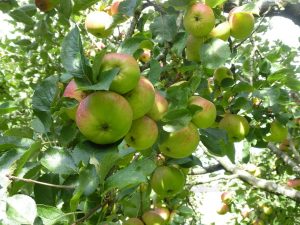A short article describing an aspect of honeybee life that would be of interest to the general public.
| Entrant ID: | 1039854 | Entrant Name: | Fiona Cook |
| Entry: | Do Trees talk with Bees?
If you have ever sat quietly on a warm Summer’s day and watched bees visiting a plant with multiple flowers you may have noticed that the bees will visit a flower before moving on to the next, then miss one or more before visiting another flower. On a single foraging trip a honey bee will visit between 50 to 100 flowers, but if you pick a single flower and concentrate on watching it you rarely see two bees land on that flower over a period of several minutes. It is well known that bees use dance as a method of communicating with each other. These dances can be complex and in the case of the waggle dance can let other bees know the direction and distance of a nectar source, and the enthusiasm of the dance will indicate how sugar rich the reward will be. But can communication occur between plants and bees? It would be useful for bees to know if a flower has been recently visited to assess the likelihood that a nectar reward will be available. It has been shown that bees can communicate using chemical messages, known as pheromones. Bees can secrete one such pheromone from their feet, so effectively leave a trail of chemicals wherever they have walked. This can be detected by the next bee to visit a flower and signal that the flower is probably not worth visiting, while the flower is replenishing the supply of nectar. In addition to the pheromones, scientists have also shown that when a bee visits a flower it can transfer some of its positive charge. This changes the charge associated with the flower, so if there have been multiple visits, the net charge of the flower could be sufficient to alert other bees to the fact that the nectar supply has been used up. However, the mighty Horse Chestnut, (also known as “Candle trees”) communicates so clearly that flowers have been pollinated that even humans can see it! A close look at the individual flowers in the candle of a white horse chestnut show that individual blooms are white with cream and yellow markings. As individual flowers are pollinated and subsequently fertilized, the markings turn pink and red indicating to both bees (and humans) that nectar is no longer available. Bees will preferably focus on visiting the nectar containing creamy-yellow marked flowers. So surprisingly, the answer to the question is that trees can indeed “talk” to bees!
A bumble bee visits a yellow marked Horse Chestnut flower to collect a nectar reward. The red marked flowers have already been pollinated/fertilized and should go on to produce conkers, but the flowers will no longer provide nectar rewards. |
||
| Result: |  |
||
| Entrant ID: | 1045696 | Entrant Name: | Jenny Higham |
| Entry: | If a honeybee could talk: What it is like to be me (compared with you)
How beautiful I am but how tiny. I weigh only a tenth of a gramme. Be very gentle with me. Like you, I came from stardust.
You and I, we share lots of the same body chemistry. My brain is minute compared with yours, but very big compared with those of other insects. I can help solve complex problems. I dance to tell other bees exactly where the best water or flowers can be found. At times I sleep, I may even dream (like you). However, I am also so different from you. Four wings, six legs, five eyes. And my skeleton is all on the outside of my body. I am so very hairy all over, even hairs growing out of my eyes, it seems. 150 million years ago we bees were once wasps – then we co-evolved with flowering plants – and went vegan. The world transformed. I don’t have a nose, but sticking out from my face are my antennae. I feel and touch with them, above all I smell with them. My sense of smell may be two hundred times more sensitive than yours, so much so that I can detect specific human diseases. Imagine my beautiful long tongue its tip so delicate, sucking up the nectar from the flowers. Nectar! Ecstasy! For energy! Taken back home for the hive. Made into honey to store, too often stolen from us…by you.
Chestnut trees in full bloom. Beautiful white, yellow and red. But bees cannot see red. The flowers are talking to us in colour language, saying come to the yellow part, the red has already been fertilised and does not now need bees.
Harvest-time. This is how the world is fed. Fruit and veg, nuts and seeds and oils, and, and… One mouthful in three of all the food you eat. This is life itself. The greatest partnership in the history of the world: pollinators and flowers. I can only be true to my own nature: loving service to the hive; a love-feast with the flowers. And you? |
||
| Result: |  |
||
| Entrant ID: | 1042567 | Entrant Name: | Gill Brewer |
| Entry: | Moving House – Honeybee Style! If you hear a humming and see a dark cloud of insects flying over your garden in summer, it may well be a honeybee swarm. The swarm has probably come from a nearby hive, which became overcrowded with bees and honey and has split into two. Left behind are the beeswax combs of brood and food, with enough bees to look after them, and queen cells from which a new queen will emerge to head the colony. The old queen and more than half the bees have left home in the swarm. The swarm may land in a tree or shrub, gradually settling into a brown mass, maybe the size of a football. The only packing the bees did before moving house was filling their stomachs with enough honey to give them energy for about three days. Both in flight and now in a cluster, the swarm is held together by pheromones – scents bees produce to communicate messages to each other. There may be tens of thousands of bees in the swarm, but they will all know the queen is safely with them, as her pheromones are passed around by bees constantly touching antennae and sharing food – smelling and tasting the messages. For somewhere between a couple of hours and a couple of days the swarm will camp in the open air. If it rains, the outer layer of bees line up using their wings like a raincoat. During this time, scout bees will go house hunting. They are searching for a good sized, dry cavity. Ideally high up away from predators, the entrance should be small and easy to guard and ideally south facing. Scouts return and preform a dance, the waggle dance, indicating the direction and distance to a potential nest site. Other scouts are recruited for a second viewing of the best sites. Only when a unanimous decision is reached, with all the scouts dancing for one site, will the bees warm up their flight muscles and fly off to their new home. The airborne swarm is guided by scouts who know the way, flying fast over the swarm, like arrows directing the traffic. Another scent is released around the nest entrance, like landing lights. Bees crawl into their new home, attracted by the queen’s scent. Some bees immediately use their stored energy to build wax combs, where the queen starts laying eggs. Others will go out foraging. They collect nectar and pollen from flowers for food, resin from trees to waterproof the nest and, in hot weather, water to air condition their home. They’re settling in nicely! The best thing to do though, if a swarm lands in your garden, is phone a beekeeper. Look on the local beekeeping association website. A beekeeper can shake the swarm into a basket, interrupting their house hunting. The bees can then be re-homed and cared for in a purpose-built hive. That’s the best thing… because it might prevent them moving into your chimney! |
||
| Result: |  |
||

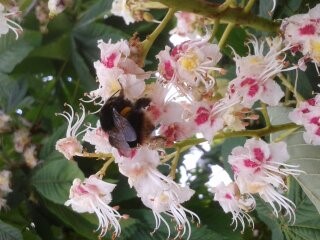
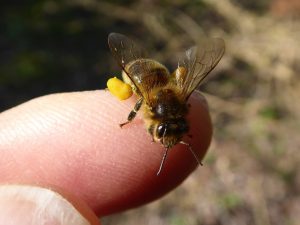
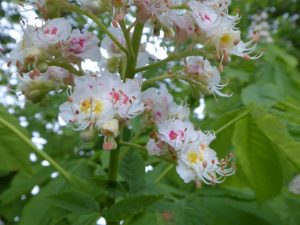 Why so hairy? Pollen matters even more: protein, fats and vitamins: body-building stuff. I can be covered with pollen from flowers. I comb it off myself and collect it on my back legs for the hive. (Could you do that?)
Why so hairy? Pollen matters even more: protein, fats and vitamins: body-building stuff. I can be covered with pollen from flowers. I comb it off myself and collect it on my back legs for the hive. (Could you do that?)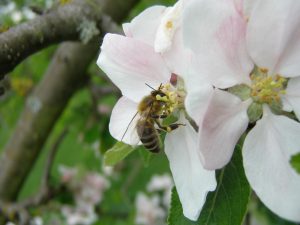 Apple blossom in the garden. For the plants, pollen is the male dust on the stamens that must land on the inner female part of the flower to fertilise it. We bees do the moving. Flower sex. How the flower lures me into itself, first with the scent wafting toward me, then with its colours and shape, the lines on the petals. I brush past the rod-like stamens with pollen at their tips, into the heart of the flower where the sweet nectar is found. Then when the flower fades, a hint of the apples beginning to form…
Apple blossom in the garden. For the plants, pollen is the male dust on the stamens that must land on the inner female part of the flower to fertilise it. We bees do the moving. Flower sex. How the flower lures me into itself, first with the scent wafting toward me, then with its colours and shape, the lines on the petals. I brush past the rod-like stamens with pollen at their tips, into the heart of the flower where the sweet nectar is found. Then when the flower fades, a hint of the apples beginning to form…